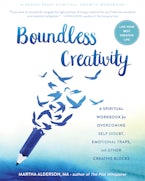By Martha Alderson, MA, author of Boundless Creativity
You have worked hard to strengthen your abilities to cope and find joy within the normal challenges of life. And then, COVID-19 hits. Suddenly, life as we’ve always known it has changed radically. With the stress of managing this new reality we’ve been thrust into—sheltering in place, quarantined, out of work, homeschooling children, isolated, running out of money, and the unknown—no wonder so many of us are finding it difficult to control how we think, feel, and act.
Our emotional reactions to the unexpected challenges we’re faced with affect our thinking and influence our actions.
Three Primary Emotions
Three emotions—fear, happiness, and sadness—create the physical sensations first to arrive in reaction to a situation. These three emotions are unthinking, instinctive responses we all share, and are at the root of every other emotion. (I include anger as a secondary emotion and a direct outgrowth of fear.)
Of these three primary emotions, which one were you most familiar with before the virus?
- Happiness
- Sadness
- Fear
Before the virus hit, perhaps you considered yourself a happy person.
And, now, which one would you say best describes your usual emotional state?
- Happiness
- Sadness
- Fear
Perhaps now you more often find yourself in the grip of sadness or fear.
Fear
Fear is a reaction to an imagined danger. Of course, COVID-19 is not an imaginary danger, though the fears you feel in association with it often center on outcomes that have not yet happened. Yes, negative outcomes may be breathing down your neck, but they might not have actually manifested in the present moment.
Sadness
Sadness activates sensations through your body to deaden the pain of not getting what you want or getting what you don’t want. Sadness, like fear, drains your spirit and your energy, interferes with your mental health, and often leads to physical complications.
Fear worries something bad will come true; sorrow believes it already has.
Happiness
We’re happy when we gain what we want. We’re happy when we avoid what we don’t want.
Similar to fear and sorrow, happiness shares the same propensity for being based on external circumstances. Happiness is a subjective state of mind; it can be gained and lost in a few moments, seconds, or hours.
While sorrow and fear can become actual ways of life, happiness is susceptible to turning to dust in the face of anything that goes against our wants and desires.
Exploration
As the news and the challenges you face turn bleaker, the emotions you feel turn dark. Negative actions, reactions, and adverse thoughts stem from fear grief and withdrawal stem from sadness. The pandemic is a prime testing ground and center of conflict, where all our sides are exposed.
We can’t do much about the virus besides taking precautions to keep our loved ones and ourselves safe. We can, however, do something about our emotional reactions to the virus and the challenges we face.
Journal what a good day feels like while you’re in the middle of productivity and feeling happy.
Journal what a low-energy, unproductive day feels like while you’re in the middle of a downturn and overcome by sorrow and fear.
An Affirmation
An affirmation—a pledge, mantra, or chant—repeated often and with meaning reprograms your brain in a way that best serves your emotional well-being.
When you’re in the throes of fear and sorrow, try repeating over and over again an affirmation that lifts your spirit, such as:
“I believe in myself.”
“I focus on what I’m grateful for.”
“I’m a hard worker and great at coming up with creative solutions to problems.”
“I override my doubts about my ability to manage the challenges I’m faced with by celebrating and giving thanks for my determination to get me here.”
“I watch for early signs of overwhelm and self-doubt so I can step in with my skill of rising above limitations.”
“When my fears threaten to turn me apathetic and sluggish, my imagination and belief in the miraculous stoke the fire inside.”
Create an affirmation for yourself that is stated in present tense, as if already true. Write it down and post the affirmation where you’ll see it—on the bathroom mirror, the refrigerator door, in the car, on your computer, and your phone.
By repeating your affirmation, you’ll slowly you find you’re able to unplug from the fear and unhappiness created by watching and listening to the news, and seeing firsthand the fallout from the pandemic. Experience what you’re feeling. Expose your dark emotions to the light. Accept the sensations. And then, flip the negative emotions to hopeful and happy feelings with the help of your mantra. As you do, you begin to control your emotions rather than be controlled by them.
Martha Alderson, MA, has been exploring and writing about plot and creativity for more than thirty years. Author of Boundless Creativity and The Plot Whisperer, Alderson works with best-selling authors, New York editors, Hollywood directors, artists, and performers from all over the world.



 Part 2: What to Do When a Client Is Participating in Self-Judgment?
Part 2: What to Do When a Client Is Participating in Self-Judgment?